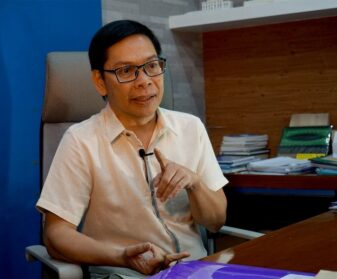
DAVAO CITY (MindaNews / 29 June)—Mindanao will need around 2,000 megawatts of new renewable energy installed capacity by 2030 to fulfill the objective set by power stakeholders of a 50:50 renewable energy:fossil fuel energy mix in the next seven years.
In a gathering of renewable energy stakeholders in Davao City last June 27, 2023, Mindanao Development Authority (MINDA) Chairperson Sec. Maria Belen Acosta boldly announced the stand of the agency she heads to push the agenda of attaining parity between renewable energy and fossil fuels in the Mindanao energy mix.
“MINDA is pushing for a 50:50 renewable, fossil energy mix by 2030. Gusto nating umunlad, but do no harm to the environment,” Sec. Acosta told participants of the Local Energy Planning Workshop organized by the Mindanao Renewable Energy Acceleration and Coordination Hub (MinReach).
This campaign seeks to fast-track Mindanao’s compliance to the target of the PH National Renewable Energy Plan (NREP) of 50:50 renewable energy:fossil fuel mix by 2040 throughout the country. The NREP target is 35:65 RE and fossil fuel mix in 2030. The NREP’s projection is to help the country comply with its nationally determined contribution (NDC) to the 2015 Paris Climate Deal.
As one of those who started the MinReach initiative in 2021, I have always thought that the current 30:70 percent ratio of RE to fossil fuels in the Mindanao energy mix is unjust and anomalous.
Renewable energy used to be Mindanao’s pride. Majority of homes and industries have been powered by clean fuels from hydroelectric power plants in the Agus Complex in Lanao del Norte and Sur, and in the Pulangi Complex in Bukidnon.
Series of policy debacles in the power industry have plunged Mindanao into darkness, necessitating the deployment of diesel generators and hasty entry of coal-fired power plants in the island. Fossil fuels eventually outpaced renewable energy right before our eyes in the last 10 years.
Growth of coal in the Mindanao grid grew from zero in 2005 to 14% in 2015, 49% in 2017 to 52% in 2022. The result is not really power-outage free Mindanao, but exorbitant power prices. Here in Cagayan de Oro it is around P15 per kilowatt hour (kwh).
According to the Department of Energy (DOE), in 2022, renewable energy accounts for 31.7% of the island’s installed capacity, while fossil fuels (coal and diesel) account for 68.3%.
“We need to understand and push for energy that is inclusive. From fossil dependent to renewable energy dominated. Let us re-green the Mindanao grid… We have established MinReach to facilitate and coordinate this energy transition,” said Romeo Montenegro, assistant secretary and deputy executive director of MINDA.
The Mindanao 50:50 by 2030 campaign is certainly not a pipe dream. MinReach has been consulting with power stakeholders, power experts and doing the numbers.
“We are counting on the 953 megawatts of indicative renewable energy projects for Mindanao, as of January 2023 which are waiting for funding and market signals to be implemented; the operation of the Wholesale Electricity Spot Market (WESM) in Mindanao; and the 11,600 megawatts renewable energy capacity throughout the country to be bid out by the DOE on July 3 under the Green Energy Auction Program,” said Migdonio Clamor, coordinator of the MinReach.
Investing in renewable energy power plants in Mindanao becomes more lucrative with WESM. Under the system, renewable energy power plants are given priority dispatch. Coupled with the Mindanao-Visayas interconnection, the current excess power from the Mindanao grid of 800-1,000 megawatts will be exported to Visayas and Luzon. WESM started operations in Mindanao last February. In May, the Mindanao-Visayas Interconnection Project (MVIP) started operating. The MVIC transmission system—which has a capacity of 450 megawatts, expandable to 900 megawatts—should now be operating at 50% and fully at the third quarter of this year.
Lawyer and energy expert Jose Layug Jr., president of the Developers for Renewable Energy for AdvanceMent (DREAM), said that at the current 30:70 energy mix of Mindanao, 50:50 by 2030 is more than doable. “The 11,600 megawatts of renewable energy generation capacity to be bid out by the DOE on July 3, 2023 means the government is serious in going renewable,” Layug, who is advocating for renewable energy as the default energy policy of the government, told participants of the recent MinReach event.
Atty. Layug said fiscal and non-fiscal incentives and climate change impacts would drive more investments toward renewable energy. He cited the pending increase from 1% to 2.5% of the Renewable Portfolio Standards (RPS) and other non-fiscal incentives being offered by the RA 9513 or the Renewable Energy Law of 2008, which the DOE is now diligently implementing. Among these non-fiscal incentives are investments in renewable energy like the Green Energy Option Program, and Net Metering.
Fiscal incentives include duty free importation of RE machineries and equipment, seven-year income tax holiday on RE projects, VAT exemption, among others.
RPS under RA 9513 requires electric utilities like electric cooperatives and power distribution companies to source at least 1% of their energy supply from eligible renewable energy generators. This was implemented by DOE in 2020 and will run until 2030. The DOE is now in the final stages of implementing the increase of the RPS to 2.5% annually.
Net metering allows users of solar energy systems of up to 100 kilowatt/hour capacity to sell their surplus energy to the grid. Sen. Lito Lapid has filed a bill to remove this 100-kwh cap to further encourage people to install solar energy systems in their homes and businesses.
The Mindanao 50:50 by 2030 campaign is unique in a way that the government and stakeholders agree on pushing it. Power consumers’ support for this campaign is essential. People should collectively stomp their feet to demand clean, efficient and affordable electricity now.
Furthermore, climate change impacts which necessitates the reduction of our collective carbon footprint add more urgency to this just transition to renewable energy.
Mindanao Reach or MinReach is a project jointly implemented by MINDA, the Peace and Equity Foundation (PEF), the Ateneo de Davao University – Mindanao Renewable Energy Center and Tara Climate Foundation. The PEF started this initiative with stakeholder consultations in 2020 and 2021, followed by a study that resulted in the Mindanao Renewable Energy Ecosystem Report published in 2022 and the establishment of the hub in November last year.
(The writer is one of the authors of the Mindanao Renewable Ecosystem Report published in 2022. He is one of the pioneers of the country’s anti-coal power movement and now a consultant of MinReach. Comments can be sent to bency.ellorin@gmail.com.)







